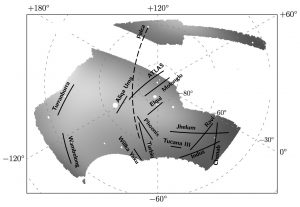Also announces discovery of eleven stellar streams, evidence of small galaxies being eaten by the Milky Way
At a special session held during the American Astronomical Society meeting in Washington, D.C., scientists on the Dark Energy Survey (DES) announced today the public release of their first three years of data. This first major release of data from the survey includes information on about 400 million astronomical objects, including distant galaxies billions of light-years away as well as stars in our own galaxy.
One new discovery enabled by the data set is the detection of 11 new streams of stars around our Milky Way. Our home galaxy is surrounded by a massive halo of dark matter, which exerts a powerful gravitational pull on smaller, nearby galaxies. The Milky Way grows by pulling in, ripping apart and absorbing these smaller systems. As stars are torn away, they form streams across the sky that can be detected using the Dark Energy Camera. Even so, stellar streams are extremely difficult to find since they are composed of relatively few stars spread out over a large area of sky.
Read more in the press release here.

This image shows the full area of sky mapped by the Dark Energy Survey and the 11 newly discovered stellar streams. Four of the streams in this diagram — ATLAS, Molonglo, Phoenix and Tucana III – were previously known. The others were discovered using the Dark Energy Camera, one of the most powerful astronomical cameras on Earth. Image: Dark Energy Survey









